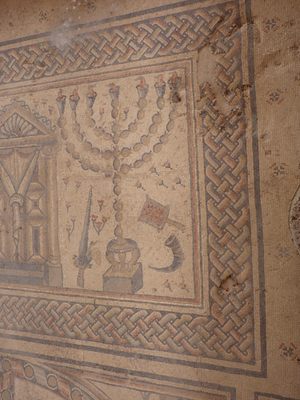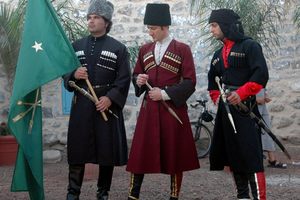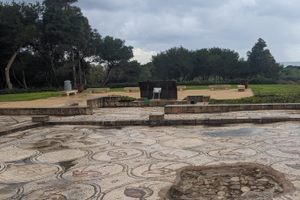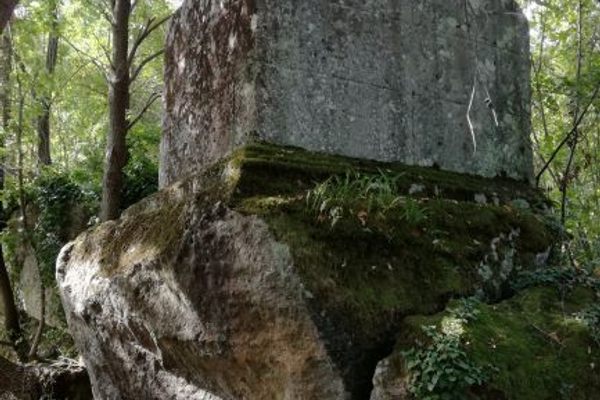About
One of the most remarkable ancient synagogue mosaics sits in a little-visited archaeological site on the Sea of Galilee near a stretch of modern sea resorts and a water park.
Hammat Tiberias, where a 4th-century synagogue once stood, was a small settlement located just south of the larger metropolis Tiberias, named after the second Roman emperor by the city's builder, Herod Antipas. Little remains of the synagogue except some foundational stones and its magnificent floor mosaic.
The less surprising part of the mosaic is its traditional depiction of a Torah ark flanked by ceremonial menorahs, shofars (ram's horns), and palm fronds. At another end, the names of the synagogue's benefactors are written in Greek, the most used language of the time, surrounded by two lions.
What turns heads is the rest of the mosaic. In the center panel sits a magnificent zodiac wheel, featuring, among other pagan images, depictions of naked humans—including a conspicuously uncircumcised Libra. The wheel encircles a haloed Helios, the Greek sun god, mounted atop his chariot. Women representing each of the four seasons sit to the corners of the zodiac, with the accompanying Hebrew inscription of the names of the seasons.
Pagan imagery in a house of worship would appear a flagrant violation of God's injunction, "Thou shalt not make unto thee any graven image," but similar synagogue zodiacs have been found in sites such as Tzippori and Beth Alpha. The nearby Beit She'arim necropolis contains hundreds of tombs decorated with mythological imagery. One scholar posits that for the Jews of this period, the zodiac, as a ubiquitous symbol of the divine order that rules over human affairs, could have served as a focal point for devotion to a God they believed had a direct effect in their daily life. The 12 symbols of the zodiac could also easily align with the 12 months of the Hebrew calendar.
When the mosaics of Hammat Tiberias were uncovered in the 1920s, the small surrounding settlement serviced the Ottoman-era bath house just footsteps away from the site of the synagogue. A natural springs forms here through cracks in the earth; temperatures can reach as high as 140 degrees Fahrenheit. A medieval myth ties the springs' creation to King Solomon, who drove a horde of devils underground, forcing them to labor to create the heat necessary for the baths. To ensure their work for him never ceased, the king made them deaf, so that the devils could never hear of his demise.
Related Tags
Published
May 21, 2018
Sources
- https://www.haaretz.com/israel-news/travel/.premium-hammat-tiberias-synagogue-mosaic-1.5279569
- https://en.wikipedia.org/wiki/Hamat_Tiberias
- https://www.myjewishlearning.com/article/astrology-in-the-ancient-synagogue/
- https://en.wikipedia.org/wiki/Tiberias
- https://en.wikipedia.org/wiki/Thou_shalt_not_make_unto_thee_any_graven_image
- https://en.wikipedia.org/wiki/Hamat_Tiberias
- https://www.haaretz.com/israel-news/travel/.premium-hammat-tiberias-synagogue-mosaic-1.5279569
- https://www.myjewishlearning.com/article/astrology-in-the-ancient-synagogue/
- https://en.wikipedia.org/wiki/Tiberias































